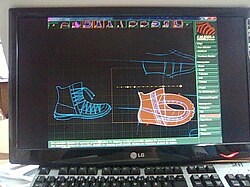This article includes a list of references, related reading, or external links, but its sources remain unclear because it lacks inline citations .(August 2010) |


CAD/CAM in the footwear industry is the use of computers and graphics software for designing and grading of shoe upper patterns and, for manufacturing of cutting dies, shoe lasts and sole moulds. CAD/CAM software is a PC-based system, which is made up of program modules. Today, there are 2D and 3D versions of CAD/CAM systems in the shoe industry.
Computer aided design was introduced in the shoe industry in the 1970s. Initially, it was used primarily for pattern grading. It enabled manufacturers to perform complex grading relatively easily and quickly. CAD systems today have been developed with a much wider range of functions. Logos, textures, and other decorations can be incorporated into product designs of both the uppers and soles to help reinforce branding on all areas of the model. It automates routine procedures, increasing speed and consistency, whilst reducing the possibility of mistakes. CAD data can now be used effectively for a wide variety of activities across footwear manufacturing business. CAD/CAM generates data at the design stage, which can be used right through the planning and manufacturing stages.
Latest improvements in the CAD/CAM technology are:
- Graphic capabilities and interconnectivity have improved enormously.
- Software developments have progressively made systems more intuitive and easier to use.
- With 2D sketch and paint modules, a serviceable sketch can be produced and then colour and texture can be added.
- 3D systems enable the last and design to be viewed from any perspective and several angles even simultaneously.
With CAD/CAM software, footwear manufacturers can cut their time to market dramatically and so increase market share and profitability. In addition, the power and flexibility of the software can overcome restrictions to the designer's creativity imposed by traditional methods.